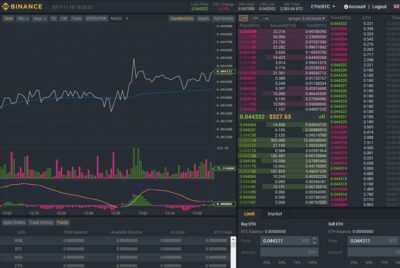What Is The Federal Reserve Balance Sheet
Contents:
- The Role of the Balance Sheet in Meeting the Federal Reserve’s Monetary Policy Mandate
- Why does the Fed’s shrinking balance sheet matter?
- The Federal Reserve’s Balance Sheet: Costs to Taxpayers of Quantitative Easing
- Here’s an easy-to-follow primer on the Fed’s assets and liabilities, and why they can affect your investments.
While that didn’t come to pass , the Fed could still face the same problem if its asset purchases were to outpace the supply of Treasuries. Additionally, an ever-increasing balance sheet would expose the Fed to even larger losses in a tightening cycle. As English and Donald Kohn of the Brookings Institution noted in a recent Brookings blog post, balance sheet losses don’t affect the Fed in the same way they would a commercial bank. The Fed cannot default or go bankrupt because it can always create reserves to cover its losses.

Fed Balance Sheet Normalization and the Minimum Level of Ample … – Federal Reserve Bank of Richmond
Fed Balance Sheet Normalization and the Minimum Level of Ample ….
Posted: Wed, 22 Feb 2023 18:05:34 GMT [source]
Our analysis indicates that the costs of QE4 will not directly constrain the FOMC’s ability to adjust the target federal funds rate to foster its dual objectives of maximum employment and price stability. However, the Fed’s large footprint in the Treasury market combined with its open-ended reverse repo facility and other factors could unintentionally exacerbate financial stresses in some adverse scenarios. There would surely have been a massive public outcry if the Fed had purchased massive amounts of corporate debt and then written off $1 trillion in losses owing to an increase in expected defaults. But such losses would have exactly the same implications for taxpayers as the net interest costs of QE4. In particular, capping credit risk also limits the central bank’s involvement in the allocation of credit.
The Role of the Balance Sheet in Meeting the Federal Reserve’s Monetary Policy Mandate
The Fed’s MBS purchases starting in 2020 helped to drive down mortgage rates, boosting housing demand, even as materials shortages and other market inefficiencies constrained supply. As of Jun. 2, 2022, they included $8.5 trillion in securities held outright. Treasury securities, mostly notes and bonds, accounted for $5.77 trillion of the total. They also signaled the Fed’s determination to keep interest rates low, encouraging investment by increasing risk appetite in financial markets. The Fed’s liabilities include U.S. currency and the reserve deposits that banks and other depository institutions hold with the bank. There’s about $1.87 trillion in circulation, so the Fed has a liability of about $1.87 trillion because of that cash.
- An explanation of the trust funds for social insurance is included in Note 23—Funds from Dedicated Collections.
- FXCM Markets LLC (“FXCM Markets”) is incorporated in St Vincent and the Grenadines with company registration No. 1776 LLC 2022 and is an operating subsidiary within the FXCM group of companies (collectively, the “FXCM Group” or “FXCM”).
- Certain material weaknesses, limitations, and uncertainties prevented the Government Accountability Office from expressing an opinion on the U.S.
- Additionally, an ever-increasing balance sheet would expose the Fed to even larger losses in a tightening cycle.
- However, as the U.S. inflation rate soared to more than 9% annually in the wake of the post-pandemic recovery and more than a dozen years of Fed monetary and government fiscal stimulus, the Fed began to reverse course.
- Not all, of course, because central banks around the world have done the same.
The 1913 Federal Reserve Act created the current Federal Reserve System and introduced a central bank to oversee U.S. monetary policy. The principle of inflation targeting is based on the belief that long-term economic growth is best achieved by maintaining price stability, and price stability is achieved by controlling inflation. Inflation levels of 1% to 2% per year are generally considered acceptable, while inflation rates greater than 3% represent a dangerous zone that could cause the currency to become devalued.
Why does the Fed’s shrinking balance sheet matter?
“Of course, even though it’s drying paint, that doesn’t mean it’s not imparting some restraint on the economy.” Securities held outright total about 95 percent of the Fed’s total balance sheet. Nearly two-thirds are Treasury securities, including shorter-term Treasury bills, notes, and bonds. Securities held outright make up about 95 percent of the Fed’s total balance sheet.

The remittances remain suspended until the deferred https://forexhistory.info/ returns to zero, at which point the extraordinary liabilities have been fully offset by a corresponding amount of positive net interest income. This deferred asset was first recorded on the Fed’s books in the third quarter of 2022. Although the Fed is likely to operate at a loss during 2023–2024, it will not need any bailout funding from the Congress. Rather, the Fed will cover those operating losses by borrowing from the public, and that cumulative amount of borrowing will then be reversed as its operating income recovers to positive levels. Our analysis indicates that the Fed’s remittances to the US Treasury will not resume until 2028 and will remain well below normal levels over subsequent years. In effect, the Fed’s reduced payments to the US Treasury will offset the cost of its balance sheet policies without requiring any new appropriation of funds by Congress.
“The Fed would rather not have this ratchet effect where the balance sheet just keeps getting bigger, because at some point, you have a problem,” says English. “I think they want to be clear that this is a counter-cyclical policy that they’ll engage in to provide support when it’s necessary, and they’ll unwind when it’s appropriate to do so.” We’re one of 12 regional Federal Reserve Banks working together with the Board of Governors to support a healthy economy.
The Federal Reserve’s Balance Sheet: Costs to Taxpayers of Quantitative Easing
Just like anyone else would buy a security as an investment, the Federal Reserve also buys securities on the open market. The Federal Reserve’s assets peaked most recently at $8.92 trillion on March 30, 2022. The claims reserve is a reserve of funds that are set aside by an insurance company for the future payment of incurred claims that have not yet been settled.

Reductions in the Fed’s MBS holdings will directly affect mortgage rates, and through them the housing market and the broader economy. Whether sales are required to reduce the balance sheet depends on the desired reduction pace relative to the maturity schedule of the holdings. The Fed’s asset purchases before the COVID-19 pandemic were mostly of long-term debt. After COVID-19 it bought securities of various durations, giving itself more flexibility to reduce those holdings through runoff. The FOMC said balance sheet reduction would continue until the point, otherwise unspecified, at which the balance sheet is just large enough to efficiently implement monetary policy, primarily by continuing to target the federal funds rate.
Here’s an easy-to-follow primer on the Fed’s assets and liabilities, and why they can affect your investments.
If the Fed were to https://forexanalytics.info/ the interest rate paid on its reverse repos to zero as well as the interest rate it pays on reserve balances, then money market rates would fall to zero and the Fed would be unable to fight inflation. The first page of table 5 presents the assets held by the Federal Reserve. The assets listed largely parallel the factors supplying reserve balances from table 1.
M2 Money Supply Drops Most Ever. What That Says About the Fed’s Next Move. – Barron’s
M2 Money Supply Drops Most Ever. What That Says About the Fed’s Next Move..
Posted: Tue, 28 Feb 2023 22:35:00 GMT [source]
The Fed resumed asset purchases on a dramatically expanded scale amid the economic slump in the early stages of the COVID-19 pandemic, buying $1.7 trillion of Treasury securities between the middle of March and the end of June in 2020. Reverse repurchase agreements, or reverse repos, are borrowings of Treasuries from commercial counterparties used to hold the federal funds rate in the Fed’s targeted range. Board of Governors of the Federal Reserve System The Federal Reserve, the central bank of the United States, provides the nation with a safe, flexible, and stable monetary and financial system.
When the Federal Reserve buys more securities, cash is injected into the U.S. financial system. Thus more money is available to banks, interest rates tend to be lower, and more people are apt to borrow money and spend it, boosting the economy. On both occasions, the Fed’s debt purchases helped to deliver relief by lowering longer-term interest rates, giving the economy a tangible boost. As an example of balance sheet reserves for a company not in the insurance company, Company XYZ must recall one of its products and issue refunds to customers. Customer refund claims are expected to come in at a steady rate for the next six months.
We also inform the public through our data and economic analysis, publications, presentations and educational resources. Depository institutions earn interest on the end-of-day balances they hold at the Federal Reserve. Additional information on the payment of interest on reserves is available at /monetarypolicy/reserve-balances.htm. It is an infrastructure adopted to manage the liabilities and assets of the Federal Reserve. The Fed’s balance sheet apparently represents a scale of the monetary nature and behavior of the US economy. The Fed’s balance sheet is often leveraged by the officials to stimulate the economy.
In May, the FOMC released detailed plans of how it will reduce the balance sheet. Besides mentioning the dollar size of the caps, it provided guidance on how it would end redemptions. In particular, as reserves are declining toward “ample,” the FOMC noted it plans to first slow and then stop the decline in redemptions when it judges reserves are somewhat above their desired ample level. In January 2022, the FOMC released a statement on its planned approach for reducing the size of the Federal Reserve’s balance sheet. The statement provided insight into how the FOMC is thinking about the appropriate size of the securities portfolio in the longer run.
Another method to https://day-trading.info/ the balance sheet by the Fed is to apply the complete breaks to any new purchase of any new bonds and let the existing bonds mature and cease to exist. Again, it helps remove the old securities entries from the balance sheet, decreasing the Fed balance sheet. The quantitative squeezing and quantitative expanding tools help reduce and increase the Fed’s balance sheet, respectively. Since the beginning of last year, the Fed has been purchasing fewer securities than are maturing, thereby reducing its balance sheet. This process is called “unwinding,” and it’s a strategy the Fed uses to keep the economy from overheating.
- As with any balance sheet, the Fed’s consists of assets on one side and equal liabilities on the other.
- U.S. paper currency, as well as money that commercial banks hold in accounts at the Fed, are counted as a liability.
- Board of Governors of the Federal Reserve System The Federal Reserve, the central bank of the United States, provides the nation with a safe, flexible, and stable monetary and financial system.
- Our baseline projection suggests that market participants likely do not expect the Federal Reserve’s portfolio to return to a more normal size until August 2017, and its composition to return to normal until September 2018.
That note also contains information about trust fund receipts, disbursements, and assets. As with reported assets, the government’s responsibilities, policy commitments, and contingencies are much broader than these reported Balance Sheet liabilities. About 95% of its assets are in government securities, and shorter and longer term Treasury obligations and mortgage-backed securities from the federally sponsored enterprises or agency. Government institutions, commercial businesses, individuals—they all have a balance sheet.

